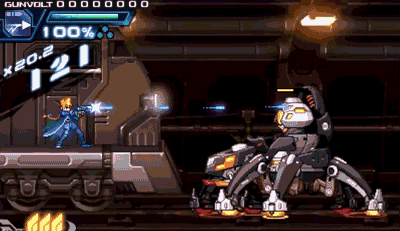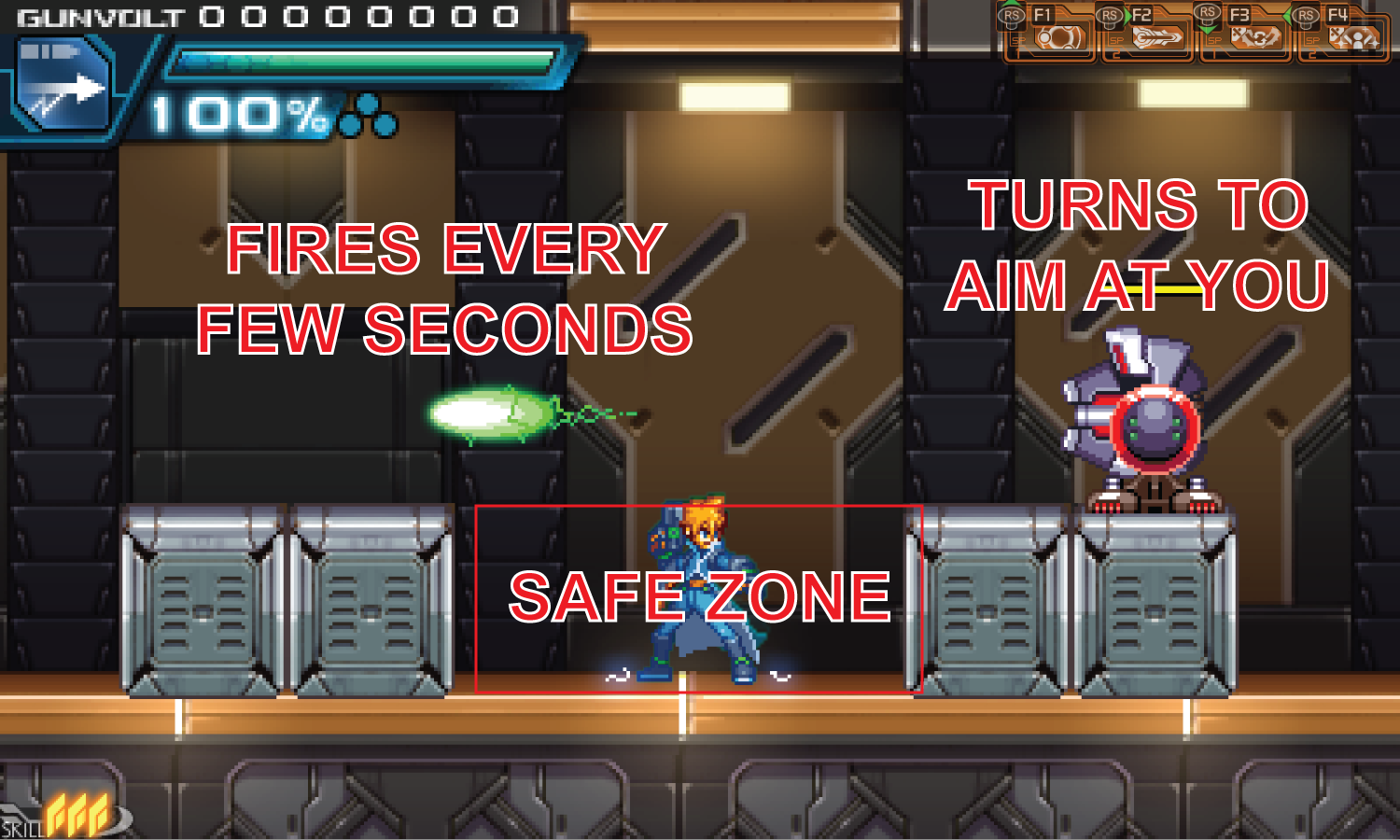
Kenneth Chen
Digital Media PhD Student
Kenneth is a doctoral student in the Digital Media PhD program. In his series “Kenneth on Games” he writes about his passion for games and game design.

If I had three words to describe Japanese game design, those words would be Azure Striker Gunvolt. This spiritual successor to Megaman Zero is stuffed with all the things we’ve come to expect from Japanese titles. Cringeworthy characters, overtutorialized dialogue… but also some great level design. I have plenty of problems with the high level concepts behind Asian games, but I’ll never turn down a good Megaman-like.
The Tutorial

Azure Striker Gunvolt starts with a fairly high level of complexity for a Megaman-like. Usually in these types of games, you shoot people and that’s it. But in Gunvolt, your bullets will tag people instead. When you’ve tagged someone, you can turn on your Flashfield, which will zap tagged enemies as long as they are within a screen’s distance of you. Tagging enemies with the gun and then shocking them with Flashfield is your main source of damage, but neither your gun nor your Flashfield alone will do much damage on their own.
Any Megaman player will instantly see the implications: you can just shoot your enemy, hide in a corner, and then Flashfield as much as you want. The classic Megaman games were all about positioning yourself so that you could get a consistent line of fire on your enemies because everything relied on your gun. If you were to look at Gunvolt‘s mechanics on paper, it seems like they would make the game ridiculously easier.
Of course, the game is balanced to present new challenges that match your higher power level. This is what the tutorial does: it not only introduces you to the Flashfield, but also to the amount of depth that it can provide and the new forms of difficulty that you wouldn’t see in a standard peashooter game.

Here’s an image of the very first enemy you encounter in Gunvolt. It’s a stationary turret that will turn to aim at you and shoot bullets at regular intervals. The setup of the boxes mean that as soon as you see the turret, it can shoot at you, so you’re forced to move forward and drop down to the floor to enter the safe zone.
So you wait here in this safe zone. You get the timing on the turret’s shots. When there’s an opening, you jump out onto the conveniently-placed box directly in front of it and tag it with your gun. Then you quickly move back down into the safe zone before it shoots again. Now that it’s been tagged, you can stay in that safe zone and Flashfield it for the kill.
This immediately teaches you that in this game, you’ll be looking for these safe zones. As soon as you tag enemies with your gun, you move to a safe location and turn on your Flashfield to kill them. You can’t just stand out in the open, otherwise you’ll get shot like you would here if you stayed on the boxes to the left.
You move on and you encounter more turrets, and new complications get thrown into the mix. There’s a turret on a box but there’s nothing else you can stand on to get on its level, so you need to jump and tag it in midair. There’s a flying turret on the same elevation as you so you can tag it right where you’re standing. Through it all, there’s a consistent theme of safe zones.
Then once you’re used to tagging enemies and running away to Flashfield, the game starts subverting these safe zones. Doors will close on you and block you into tight corridors with no cover. Enemies will shoot homing rockets that track you. Some guys will have shields that block your gunfire, and you’ll be forced to put yourself in dangerous situations to tag them.

Everything comes together in the boss battles, as expected from a Megaman-like. Here, the boss shoots homing rockets followed by a barrage of machine gun fire. There’s a bunch of boxes you can hide behind, which will block the rockets, but not the machine gun. There is no true safe zone here like there was in the previous encounters. Go up on top of the boxes, and the rockets will come for you. Stay on the ground, and the machine gun will hit you.
You need to make your own safe zone. One simple tactic would be to hide behind the boxes until the rockets are done, then jump on top until the machine gun fire is done. But Gunvolt’s Flashfield can actually destroy the rockets, so this battle becomes even easier: stand on top of the boxes and keep your Flashfield on and you’ll never get hurt. It’s a little intimidating to stand up to something like this, but it’s a skill you’ll have to learn sooner or later.
This GIF actually shows the miniboss of this stage. The real boss is the exact same thing but without the crates, so you’ll have to jump over the machine gun fire. At this point, you’ll see that the game won’t be handing easy safe zones to you anymore. You’ll need to be proactive with your Flashfield and your movement to find avenues of safety for yourself. Even though Gunvolt’s Flashfield makes him mechanically more powerful than the old peashooter Megaman, the game itself ramps up its combat scenarios to compensate.
Level Design… To What End?
On one hand, I can appreciate this direction. It means that lower-skilled players can take their time, moving slowly from each safe zone to the next as they peek out to shoot their enemies. Higher-skilled players can rush through, tag enemies, and Flashfield as they keep moving forward.
However, all of this leads to a big problem: memorization. If you go through the levels enough times, you’ll eventually remember the positions of every enemy. You’ll know exactly how to line up your shots for double or triple kills. An ambush will never surprise you. It stops being about reacting to new situations, and instead it becomes a question of how well you can execute the situation you already know about. Are you really playing Azure Striker Gunvolt, or are you playing a glorified version of Bop-It?
High level Gunvolt play, like high level play in Megaman games, always boils down to memorization. Is that really the healthiest kind of skill? When you know where to stand to avoid damage, it just becomes a question of standing there. Bosses eventually become “solved” like puzzles. Levels have optimal paths. It’s too hard the first time when you don’t know anything, but then it’s too easy the hundredth time when you know everything.
It feels so awesome to jump into a group of enemies, tag them all perfectly, and get a clean multikill. But that experience really suffers when you already know that the enemies are there, and that this specific place is a safe zone, and all you have to do is press your buttons in the right order to make everything happen.
The modern roguelike movement already solves this problem by forcing you to improve your skills rather than improve your memory. But sometimes it feels that games in hardcore genres (Megaman-likes, Souls-likes, bullet hells) often follow the strict predetermined memorizable level design philosophy. That’s not to say that one approach is better or worse than the other: I still love Gunvolt, and I’m infamous for hating randomization. Maybe there’s some kind of third way.
But I’ve said too much. Part of the magic of Gunvolt or any other Megaman-like is discovering each new level for the first time. Now, the real question is… will Azure Striker Gunvolt 2 beat Mighty No. 9 to release?
